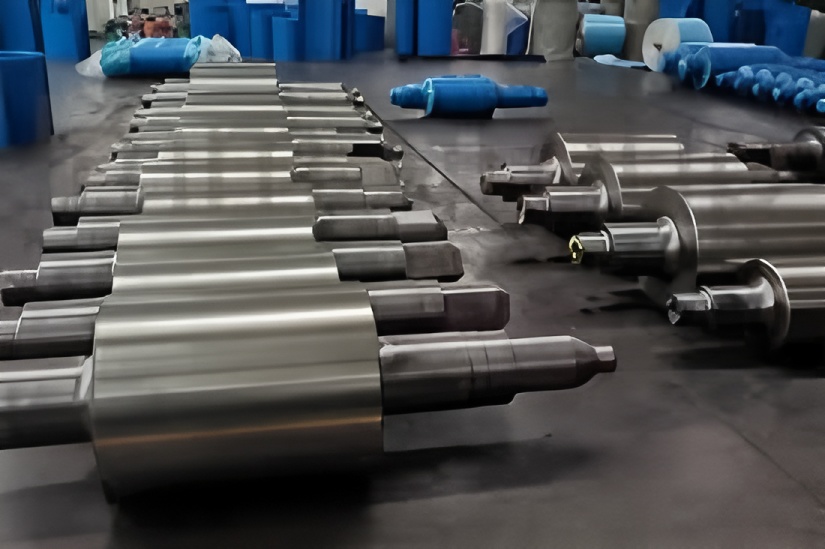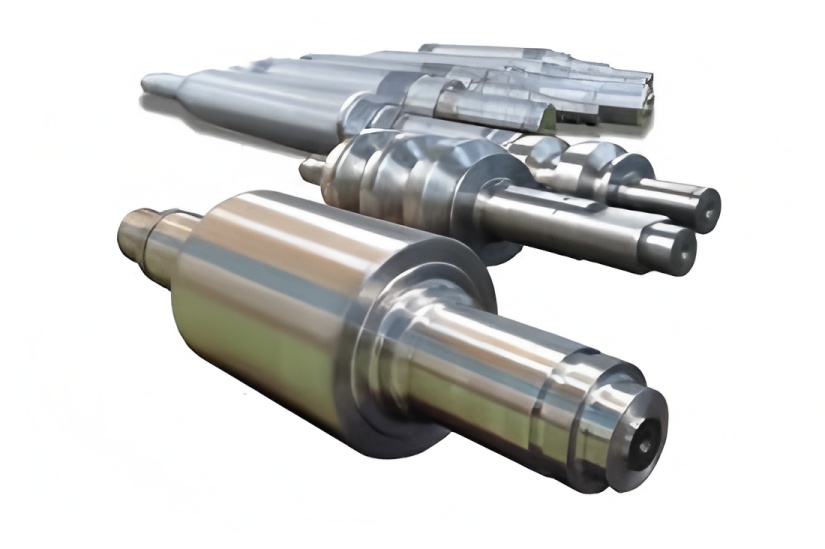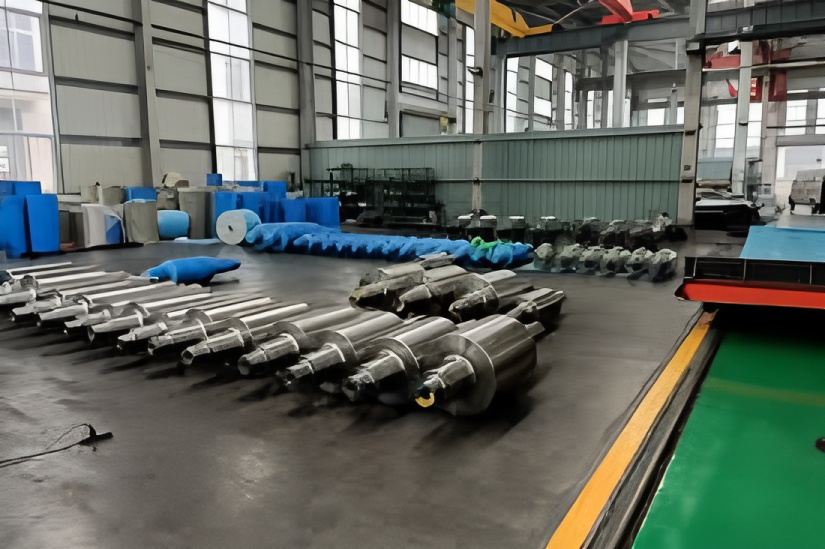This article examines the composition design of high-speed steel composite rolls. It analyzes process parameters during centrifugal casting from the perspectives of alloy element segregation and casting defects. Additionally, in line with machining quality requirements for high-speed steel composite rolls, the influence of grinding parameters on surface roughness is briefly discussed.
Keywords: High-speed steel composite roll; HSS rolls
As critical components in rolling mills, rolls significantly influence production costs, processing efficiency, and the quality of rolled products. Commonly used roll materials include high-speed steel rolls, indefinite chilled cast iron rolls, semi-steel rolls, and high-chromium cast iron rolls. Among these, high-speed steel rolls offer distinct advantages such as high carbide hardness, excellent thermal stability, good hardenability, strong thermal crack resistance, ease of forming an oxide film during operation, and extended roll change cycles. They are widely used in both hot and cold rolling mills for ferrous and non-ferrous metals.
HSS ROLLS Manufacturer
Material Requirements for High-Speed Steel Composite Rolls
During rolling, the working layer of the roll causes plastic deformation in the rolled material under pressure. Depending on rolling conditions, this layer must possess high hardness, wear resistance, and tempering stability. Simultaneously, the roll must exhibit sufficient toughness to avoid fracture under localized overload. Most domestic and international rolls use bimetallic composite materials, with the core made of high-toughness material and the working layer of high-wear-resistance material. These are combined through specific preparation processes to achieve both high wear resistance and good impact resistance. High-speed steel composite rolls are a representative type of bimetallic composite material, featuring a high-speed steel working layer and a nodular cast iron core.
Composition Design of the Working Layer in High-Speed Steel Composite Rolls
Carbon Content Selection
To ensure high wear resistance, the roll’s working layer must contain a certain amount of carbides, typically above 15%. Carbon is the primary element forming carbide hard phases. Traditional high-speed steel usually has a carbon content between 0.7% and 1.5%. In high-speed steel rolls, most carbon exists as alloy carbides, with a small amount dissolved in the matrix. During quenching,部分carbides dissolve into austenite, enhancing martensite hardness. During tempering, alloy carbides disperse and precipitate, causing secondary hardening. Undissolved carbides inhibit grain growth and provide wear resistance. Matrix carbon content below 0.3% weakens heat treatment effects, while exceeding 0.6% increases retained austenite and plate martensite, reducing fracture toughness. The carbon content in high-speed steel rolls, particularly the ratio to carbide-forming elements, critically affects performance. Low carbon content reduces hard phase volume, while high carbon content promotes carbide segregation and reduces toughness. Based on empirical formulas and practical production, the optimal carbon content ranges from 1.8% to 2.8%.
Chromium Content Selection
Chromium, a carbide-forming element, produces M₂₃C₆ and M₇C₃ carbides. Low chromium content leads to preferential matrix wear, material adhesion, increased surface roughness, higher rolling friction, and greater rolling force. Increasing chromium content improves roughness resistance, reduces rolling force, and enhances thermal shock resistance. Chromium content is generally controlled between 4% and 6%.
Tungsten and Molybdenum Content Selection
Tungsten and molybdenum enhance tempering resistance stability and red hardness. Tungsten, primarily existing as M₆C, significantly improves wear resistance. Partial dissolution into austenite during high-temperature quenching improves hardenability, while solid solution strengthening enhances matrix strength. Low tungsten content reduces carbide quantity and wear resistance, while excessive tungsten increases ledeburite, coarsens carbide particles, and adversely affects thermal fatigue. Tungsten content is typically controlled between 5% and 8%. Molybdenum, with similar properties, is maintained at 3% to 5%.

Vanadium Content Selection
Vanadium has a strong affinity for carbon. Increasing vanadium content lowers the eutectic reaction temperature and raises VC formation temperature. Vanadium promotes VC and lamellar M₂C carbide formation. VC, with hardness exceeding HV3000, remains undissolved during high-temperature austenitization, refining grains and improving wear resistance. Excessive vanadium causes grain boundary cracks, matrix wear, material adhesion, surface roughness, and reduced rolled product quality. It also complicates grinding due to high VC hardness. Vanadium content between 4.0% and 6.0% yields optimal results.
Other Elements
Niobium addition in centrifugal casting reduces VC segregation and enhances overall performance. Cobalt improves high-temperature wear resistance in hot-rolled rolls but increases pearlite transformation critical cooling rate, reducing hardenability. Its content is kept below 5%. Nickel enhances matrix toughness, but excessive amounts increase retained austenite, requiring additional tempering and reducing wear resistance. Optimal nickel content is below 2%.
Centrifugal Casting Process Control for High-Speed Steel Rolls
Common forming methods include centrifugal casting (CF), continuous casting composite (CPC), spray deposition (Osprey), hot isostatic pressing (HIP), and electroslag remelting (ESR). Centrifugal casting is the most widely used.
In this method, molten metal is poured into a rotating mold, forming a dense outer layer under centrifugal force. The roll neck and core are cast afterward. This process yields a dense structure, few defects, good mechanical properties, high surface hardness, long service life, and high production efficiency. However, alloy element segregation and casting cracks are major defects affecting quality.
Control of Alloy Element Segregation
Conventional centrifugal casting causes significant segregation. Adding niobium increases MC carbide density, with (V, Nb)C composite carbide density接近molten steel, reducing segregation and improving wear resistance. Electromagnetic fields also reduce segregation; studies show that at 0.053T magnetic field intensity, segregation of tungsten, molybdenum, and vanadium decreases by 60.6%, 31.9%, and 62.7%, respectively. Magnetic fields also reduce retained austenite, modify carbide type and distribution, increase MC carbides, improve macrohardness, and reduce grain boundary networking.
Control of Casting Cracks
High-speed steel rolls are prone to cracking during centrifugal casting. Molten steel pretreatment can reduce scrap rates. Specific steps include adding ferrovanadium particles (0.80%~1.2% of molten steel weight) during tapping, pre-adding rare earth magnesium alloy (0.30%~0.80%) and ferrochromium nitride (0.20%~0.50%) to the ladle, and adding ferrovanadium and ferrotitanium particles (5~8 mm, 0.30%~0.80% and 0.40%~1.00%, respectively) during pouring. Variable-speed centrifugal casting, variable-flow pouring, and variable-speed solidification cooling adjust temperature and stress fields to eliminate cracks.
Grinding Process Control for High-Speed Steel Rolls
Surface quality is crucial for finished product quality. Common defects include scratches, tool marks, naps, and burns. Grinding accuracy and surface quality depend on grinder precision, appropriate grinding wheels, coolants, and process parameters.
Grinding Wheel Selection
Selection is based on roll material, hardness, surface roughness requirements, and abrasive type, grain size, hardness, and bond.
Abrasive, Grain Size, and Bond Selection
Abrasive hardness should exceed workpiece material hardness by 2–4 times. Corundum abrasives with high toughness are suitable for high-tensile-strength materials. Common abrasives for alloy steel include white corundum, chrome corundum, microcrystalline corundum, and single-crystal corundum, with the latter being optimal.
Coarse grains (20–40 mesh) are for rough grinding, fine grains (60–100 mesh) for fine grinding, and very fine grains (80–120 mesh) for precision grinding. Mirror grinding uses W63–W35 wheels.
Bonds include ceramic, silica gel, rubber, shellac, and resin. Resin bonds are for mirror grinding; ceramic bonds are preferred for other grinding due to rigidity, durability, high-temperature resistance, shape retention, and stability.

Grinding Wheel Hardness
Hardness indicates abrasive-bond bonding strength. Softer wheels wear quickly; harder wheels cause clogging, burns, and naps. Softer wheels are for harder roll surfaces; harder wheels are for fine and form grinding to maintain shape accuracy.
Grinding Parameters
(1) Grinding Wheel and Roll Speed
High speeds cause vibration, leading to polygons, spirals, and burns. Rough and fine grinding use 25–35 m/s; superfinishing and mirror grinding use 15–20 m/s.
Low roll speeds cause burns and spiral marks; high speeds cause vibration and ripple depth. Rough grinding: 20–40 r/min; fine grinding: 15–28 r/min; polishing: 10–15 r/min.
(2) Longitudinal Feed
Feed rate affects surface roughness. Higher feed increases grinding force and heat, causing spiral marks. Typical range: 80–400 mm/min.
Conclusion
Ensuring the quality of high-speed steel composite rolls requires attention to every stage: composition design, casting, heat treatment, and machining. Process parameters must be tailored to the rolled products and operating conditions to optimize design, reduce costs, and promote widespread application of high-speed steel composite rolls.


